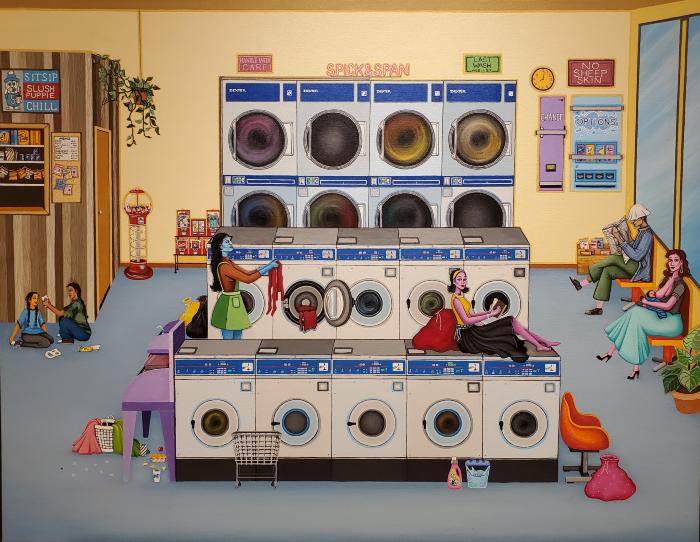Spick and Span
Robyn Tsinnajinnie (created by)
Mattatuck Historical Society (owned by)
Robyn Tsinnajinnie (previously owned by)
Mattatuck Historical Society (owned by)
Robyn Tsinnajinnie (previously owned by)
2022 (Date manufactured/created)
acrylic
canvas
34 in H
X
44.125 in W
X
1.625 in D
Measurement Notes: unframed; on stretcher only
Commentary by the artist via private correspondence:"As far as meaningful colors, Red would mainly be the only one to really signify something important. In the painting, there is a blue colored woman dressed in green denim and long sleeves, with large hoop earrings. I wanted her to appear younger because the ‘clothes’ she is pulling out of from the washing machine are shaped like deflated human figures, signifying all the lost women. I feel that it’s a way to show how Native women have to deal with the fact of knowing how many Indigenous women go missing each year. The signs on the back wall of the laundromat have two signs that will say “last wash - age 12” and “Handle with care” . Both of the signs touch on the fact that when most girls turn the age 12, some get their first period and began life as a ‘young woman’. However, when becoming a ‘young woman’ they're expected to take on all the stereotypical treatment of how people perceive women. The “no sheep skin” sign however doesn't have much significance other than it being a sign I had seen in a laundromat when I was younger and to touch on how sheep is significant to the Dine people. The other significant text in the painting is the “options” vending machine in the back right of the laundromat. The vending machine has four options; “abortion”, “birth control” “IUD” and “condoms”. Its supposed to signify how women should always have options when it comes to their own reproductive decisions; no matter their situation or status. The catch is that you have to pay in order to receive the option.Lastly, the candy vending machine in the back left of the painting has a temporary tattoo slot titled “white bread”. The children sitting under the concession stand to the left of the painting, appear to have bought a temporary tattoo of ‘white bread’. This refers to one of my other paintings where I have a mother figure putting on a white mask over her child's face and a school bus waiting outside the window. This was to signify how some native mothers may feel when sending their children to school because of their ethnicity or appearance. Bringing it back to the children in this painting, they’d bought a ‘white mask’ as a playful gesture in preparation to face the world as a young native child."Additional commentary by the artist: "If you look closely, it's a spin off of my other painting "Cold Water." This is the entire laundromat that home girl is in, and there's also some little details from some of my other paintings. It's also a rendition of the laundromat that I used to go to growing up. What the painting represents are the responsibilities and expectations that people have on women when it comes to dealing with trauma and emotions. Women have to "wash" away big life events and ignore self care in order to take care of other people instead of remembering to care for themselves.""With this painting I wanted people to think back to their own childhood laundromats and how they felt being there. Also note how it was our mothers and grandmothers who took us for "laundry days"...It's nice to think about nostalgic feelings but now it makes me think about all the mothers and women who hold their problems/troubles/traumas in and have to go on living life like nothing happened. It gives a new perspective of what the women in our lives might be feeling or have had to overcome silently."
Museum Purchase, Acquisitions Fund, 2022
2023.1.1
